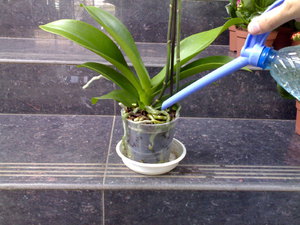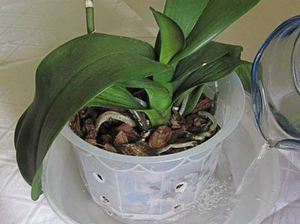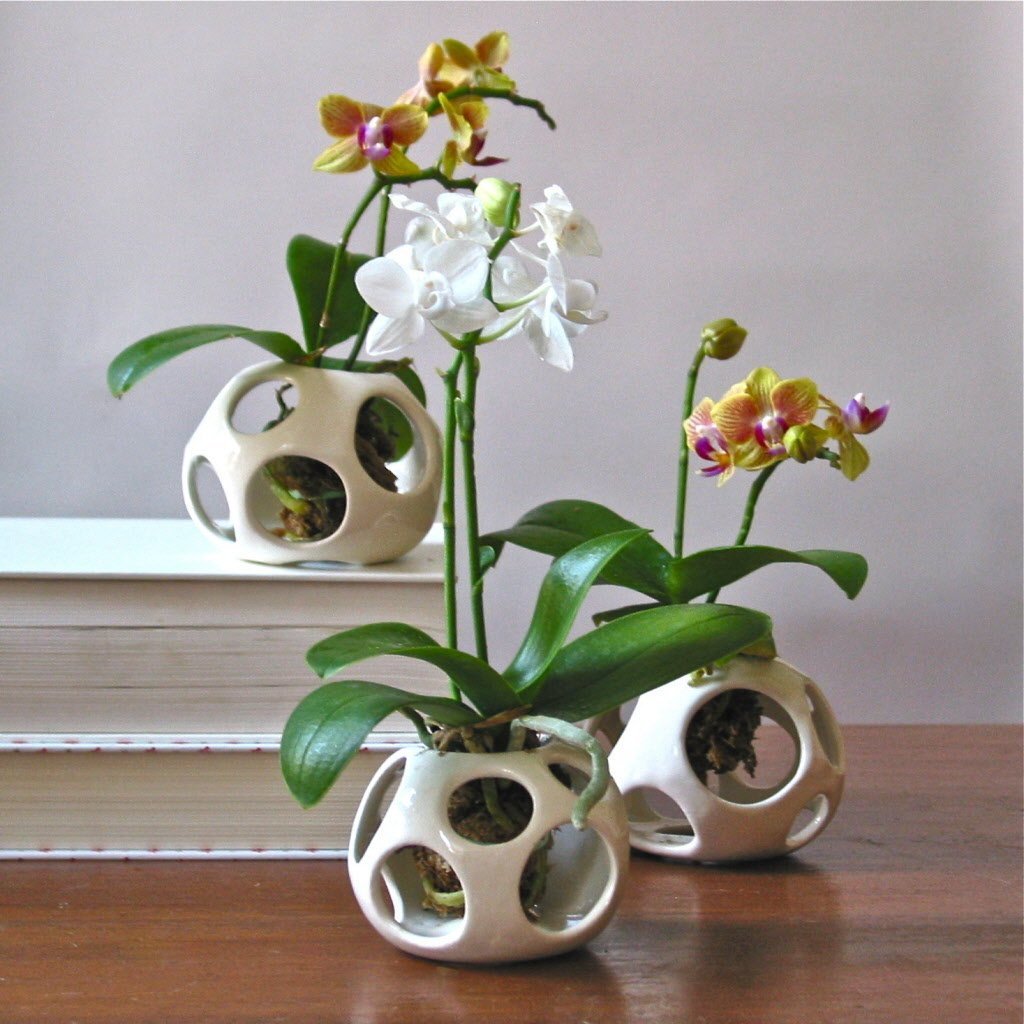In order for the Phalaenopsis orchid to grow healthy and delight the eye with its beautiful flowers, you need to know how to properly water the plant. Delicate orchids are especially sensitive to watering.
If the phalaenopsis is not properly watered, the plant will wither quickly. Therefore, every novice and experienced gardener must know the technology of watering and caring for phalaenopsis.
Orchid watering time
Mandatory rule that must be followed strictly. Phalaenopsis can only be watered with dry roots and dry substrate... You need to remember forever, first good drying, then watering. Drying can take several days. This will not harm the plant.
Drying time is of no small importance for a flower. The best option is to dry the substrate and orchid roots within 24 hours. This period applies to all types of epiphytic orchids.
Of course, the drying time largely depends on the climatic conditions. When it is cloudy and rainy outside, the drying time of the substrate is longer than on warm sunny days. Every gardener must take this factor into account.
Phalaenopsis should not be in a wet substrate for a long time. If it does not remain wet for a long time, it is necessary to replace it and pour in a larger substrate, it will begin to dry much faster, due to the free space formed inside.
You need to water orchids:
- In summer - 3 times a week;
- In autumn - once a week;
- In winter - once every 7 days.
The above watering schedule can be changed, it all depends on the individual conditions in which the orchid is grown.
How to know if the substrate and roots are well dried
 Unfortunately, the substrate dries out in different places in the pot in different ways, especially if it contains fine fractions. The layer lying on the surface dries faster, since it is more exposed to hot sunlight. Medium dries much longer, he practically does not see the sun. This also applies to the lower layer, when the orchid stands on the windowsill and is heated by a heating radiator.
Unfortunately, the substrate dries out in different places in the pot in different ways, especially if it contains fine fractions. The layer lying on the surface dries faster, since it is more exposed to hot sunlight. Medium dries much longer, he practically does not see the sun. This also applies to the lower layer, when the orchid stands on the windowsill and is heated by a heating radiator.
To determine if it is possible to start watering phalaenopsis, you can use several ways:
- Determination of the mass of the pot. After watering, you need to lift the pot and feel its weight. After a couple of days, the orchid pot needs to be picked up again. If it has become much lighter, then it is time to water.
- Pick up the top crust of the soil, lower your finger to determine what is the moisture content inside the soil.
- You can also use a small wooden stick. To determine if it is time to water the phalaenopsis, you need to get it out and see how dry it is. If the stick is wet, it means that the drying has not gone completely. Better to refrain from watering the orchid.
- You can also plant phalaenopsis in a transparent pot. A wet substrate will be much darker than an already dried substrate. Wet roots of an orchid are green in color, completely dry acquire a silvery hue.
How to properly water orchids
The best watering method is to submerge the orchid pot in a container filled with water. You need her there hold for about 15 minutes... In winter, five minutes will be enough. During this time, the roots together with the substrate will get well wet.Then the pot is taken out and the water is allowed to drain completely.
Very often, they ask the question: how to water the phalaenopsis orchid so as not to harm it. It is better to water the plant in the morning, so that it can dry well until the evening. This is also due to the properties of the orchid. She very actively "drinks" water during the daytime. If you water your orchid in the evening, its substrate will dry out much longer.
Which shower to choose for an orchid?
Florists claim that hot showers have a profound effect on the orchid. She blooms for a very long time and often... Flowers become more beautiful, she stops responding to all kinds of diseases.
Of course, this procedure is very useful, but still the shower should not be very hot. It is intended only for washing off dust from plants.
Among the many types of orchids, not everyone can take a shower well. These include:
- Cumbria;
- Miltonia;
- “Shoes;
Water temperature plays a huge role. It should not exceed 40 ° C. Otherwise, phalaenopsis will just boil.
After a shower, it is imperative to soak all hard-to-reach places where water may have gotten with a napkin. We are talking about the point of growth and leaf sinuses.
There are several contraindications for orchid shower. It is forbidden to conduct a hot shower for phalaenopsis who are at rest. Usually, this applies to the autumn and winter periods.
What kind of water is good for irrigation?
 For the orchid, this issue is also considered very important. We sometimes have very bad water from the tap, with impurities and rust... The question sounds quite natural: how to water Phalaenopsis if there is no good, clean water.
For the orchid, this issue is also considered very important. We sometimes have very bad water from the tap, with impurities and rust... The question sounds quite natural: how to water Phalaenopsis if there is no good, clean water.
For proper watering, the water must first be filtered and then boiled. As a result, it will become softer, all impurities will be removed from it. You can also use distilled water.
In principle, distilled water is already the ideal of purity. But it lacks useful trace elements and salts. In this regard, in order to water house plants with distilled water, it is imperative to add the missing microelements to such water, together with fertilizers.
If you water Phalaenopsis with hard water, in which there are a lot of salts, the roots begin to become covered with a white coating. It needs to be washed off. Any acidic environment is suitable for this, for example, kefir or lemon juice with water.
Lighting
For flowers to grow well, they need to create the appropriate conditions. Proper lighting is very important. In the summer, the flower should bathe in the sunlight, and in the winter, you can create additional lighting by connecting a fluorescent lamp.
If you properly water the orchid and adhere to the technology described above, you can grow a beautiful home phalaenopsis.


